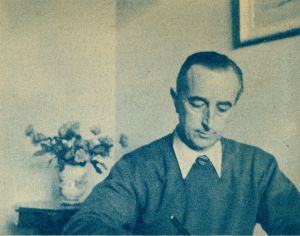Who was Hubert Benoit?
|
The following description of Hubert Benoit (pronounced roughly as Oo-behr Ben-wah, with the emphasis on the latter syllable of each name) comes from John Fitzsimmons Mahoney's preface to his translation of Benoit's last book, The Interior Realization, published in 1979:
* His obituary was sent to me by Mrs. Mignon Deming, who studied the Benoit material for many years and corresponded with Dr. Benoit: We learned with great sadness of the death of Dr. Hubert Benoit, who died on October 28, 1992, in Paris. The funeral service took place in the strictest privacy at Père Lachaise (Cemetery) last Wednesday, November 4. Descendant of a well-read family, Dr. Hubert Benoit, who was born in Nancy on March 21, 1904, felt the need throughout his life to understand the human condition and to seek the path of timeless fulfillment of man. However, he first dedicated himself to medical studies, interned in Paris hospitals, and specialized in surgery. He practiced this art from 1935 until 1944. He was part of the civil defense of Saint Lô, and just when the allies landed, he was seriously wounded in several parts of his body during the terrible bombing that practically destroyed Saint Lô. He underwent several operations during the four years that followed, but his right hand which was very much affected, remained partially paralyzed, and this obliged him to abandon his career in surgery. During his long convalescence, he increased his understanding of the human being from the perspective of Traditional Metaphysics and particularly of Zen. After that, he dedicated himself to writing, in diverse works, about the results of his research while at the same time helping readers who came to seek him out. We believe that Dr. H. Benoit was one of the rare researchers of his time whose method bridged the particular psychological case and the general metaphysical laws necessary for a deep understanding of the symptoms. It must be said that his work "The Supreme Doctrine according to Zen Thought" was greeted at the time of its publication as a major original work. In his beautiful preface to this work, Swami Siddheswarananda (who founded the Ramakrishna Vedantic Center near Paris) demonstrates his admiration for the man and the thinker. The Swami, who became influential in the years after the war, was a great thinker as well and his books are still used as references. * A well-read friend, Vince Lepidi, told me that Benoit was a student of G.I. Gurdjieff, which I had never heard. His source was James Moore's "Gurdjieff: A Biography, The Anatomy of a Myth." Moore mentions Benoit along with René Daumal and Luc Dietrich as Gurdjieff pupils. Walter Driscoll, editor of the Gurdjieff International Review (see Sources & Links page), confirmed in correspondence that Benoit was a student of Gurdjieff's.
|
 I would like to say a few words about Dr. Benoit's life, for he exemplifies
a combination of qualities seldom found today: wide learning, the highest
degree of scientific and artistic skill, and great courage. After
completing his medical and musical studies (he was a prize violinist at the
Nancy Conservatory), he practiced surgery for twelve years. During the
crucial period of the Allied landing in Normandy during World War II, he
was trapped in a house during a period of annihilation bombing at St.-Lo
and was severely wounded. He spent years in a hospital bed but miraculously
recovered. He then went into psychiatry, which he has been practicing for
the last thirty-five years in Paris. He has written a number of books that
have appeared in many editions in both Europe and the United States:
Metaphysics and Psychoanalysis, The Supreme Doctrine, The Many Faces of
Love, and Let Go! He also wrote the introduction to the French
edition of D.T. Suzuki's classic work, The Zen Doctrine of No-Mind.
I might add that he personally feels that this work, The Interior
Realization, is his best. It represents a distillation of his thought
and research over the last thirty-five years.
I would like to say a few words about Dr. Benoit's life, for he exemplifies
a combination of qualities seldom found today: wide learning, the highest
degree of scientific and artistic skill, and great courage. After
completing his medical and musical studies (he was a prize violinist at the
Nancy Conservatory), he practiced surgery for twelve years. During the
crucial period of the Allied landing in Normandy during World War II, he
was trapped in a house during a period of annihilation bombing at St.-Lo
and was severely wounded. He spent years in a hospital bed but miraculously
recovered. He then went into psychiatry, which he has been practicing for
the last thirty-five years in Paris. He has written a number of books that
have appeared in many editions in both Europe and the United States:
Metaphysics and Psychoanalysis, The Supreme Doctrine, The Many Faces of
Love, and Let Go! He also wrote the introduction to the French
edition of D.T. Suzuki's classic work, The Zen Doctrine of No-Mind.
I might add that he personally feels that this work, The Interior
Realization, is his best. It represents a distillation of his thought
and research over the last thirty-five years.